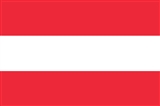
. It is bordered by the Czech Republic
and Germany
to the north, Slovakia
and Hungary
to the east, Slovenia
and Italy
to the south, and Switzerland
and Liechtenstein
to the west. The territory of Austria covers 83855 square kilometres (32,377 sq mi) and has a temperate and alpine climate
. Austria's terrain is highly mountainous due to the presence of the Alps
; only 32% of the country is below 500 metres (1,640 ft), and its highest point is 3798 metres (12,461 ft).
996 Emperor Otto III issues a deed to Gottschalk, Bishop of Freising, which is the oldest known document using the name ''Ostarrîchi'' (Austria in Old High German).
1192 Richard the Lion-Heart is captured and imprisoned by Leopold V of Austria on his way home to England after signing a treaty with Saladin ending the Third crusade.
1246 With the death of Duke Frederick II, the Babenberg dynasty ends in Austria.
1335 Otto the Merry, Duke of Austria, becomes Duke of Carinthia.
1379 Treaty of Neuberg, splitting the Austrian Habsburg lands between the Habsburg Dukes Albert III and Leopold III.
1571 Austrian nobility is granted freedom of religion.
1709 Battle of Malplaquet: Great Britain, Netherlands and Austria fight against France.
1718 The Treaty of Passarowitz between the Ottoman Empire, Austria and the Republic of Venice is signed.
1740 Maria Theresa takes the throne of Austria. France, Prussia, Bavaria and Saxony refuse to honour the Pragmatic Sanction and the War of the Austrian Succession begins.
1743 Great Britain, Austria and Savoy-Sardinia sign the Treaty of Worms.

